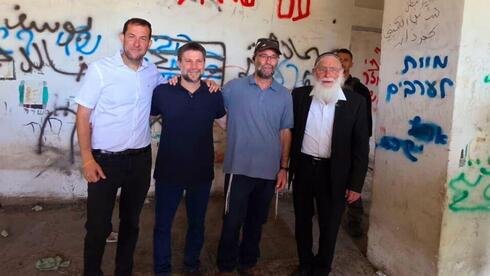Smotrich, photographed at a site defaced with graffiti reading “The people of Israel return to Sa-Nur!” and “Death to Arabs,” later shared a sanitized image without the offensive text, distributed by the council.
“We saw the graffiti after the photo was shared and completely disavow it,” The Finance Ministry said in a statement. “What pains the media isn’t a foolish graffiti that no one noticed, but that Minister Smotrich is leading a settlement and security revolution in Judea and Samaria unseen for decades.
“We’re proud to lead the correction of the northern Samaria expulsion and renew settlement in Sa-Nur with great love for our people and humanity,” the statement added.
The visit, joined by Shomron Regional Council head Yossi Dagan, who was expelled from Sa-Nur 20 years ago, took place in a remaining structure repeatedly reoccupied by settlers despite evacuation orders under the Disengagement Law.
In May, the Cabinet also recognized 22 additional West Bank settlements. “The fight against the expulsion was fierce and we hoped to prevent that terrible folly, but we knew even then that we’d return to every place we were evicted from,” Smotrich said, referencing both Gaza and the West Bank.
Smotrich framed the cabinet’s decision to repeal the Disengagement Law and establish 50 settlements, including Sa-Nur’s revival, as a testament to Israel’s commitment to its settlers. “This is the nation’s expression of trust in those who dedicate their lives to settling our land,” he said.
He argued that abandoned northern West Bank settlements once protected Israel’s Sharon region and their evacuation led to the rise of “terror hotbeds” that Israel has been combating over the past year. The minister’s visit underscores a broader push to reassert Israeli presence in areas evacuated two decades ago, aligning with his hardline stance on settlement expansion.
Dagan, reflecting on the personal and national significance of the moment, celebrated the visit as a historic correction. “Twenty years after the injustice of the expulsion, we’re privileged to partake in its rectification,” he said.
Dagan, who was among those displaced in 2005, described returning to Sa-Nur with Smotrich and IDF forces as an organized group, marking the first official step to permanently reestablish the settlement.
“For 20 years, we fought and swore we’d never rest until we returned to fix this crime. Today, we began cleaning and preparing the settlement,” he added, vowing to continue until Sa-Nur and other evacuated communities are fully restored and recognized.
The revival of Sa-Nur, backed by the government’s recognition, stirs debate amid ongoing regional tensions. The settlement’s history, tied to the controversial disengagement and the inflammatory graffiti seen during the visit, highlights the divisive nature of Israel’s settlement policy.
As Smotrich and Dagan push for a broader return to evacuated territories, their actions signal a determined effort to reshape the West Bank’s demographic and political landscape, with implications for both Israeli and Palestinian communities.




